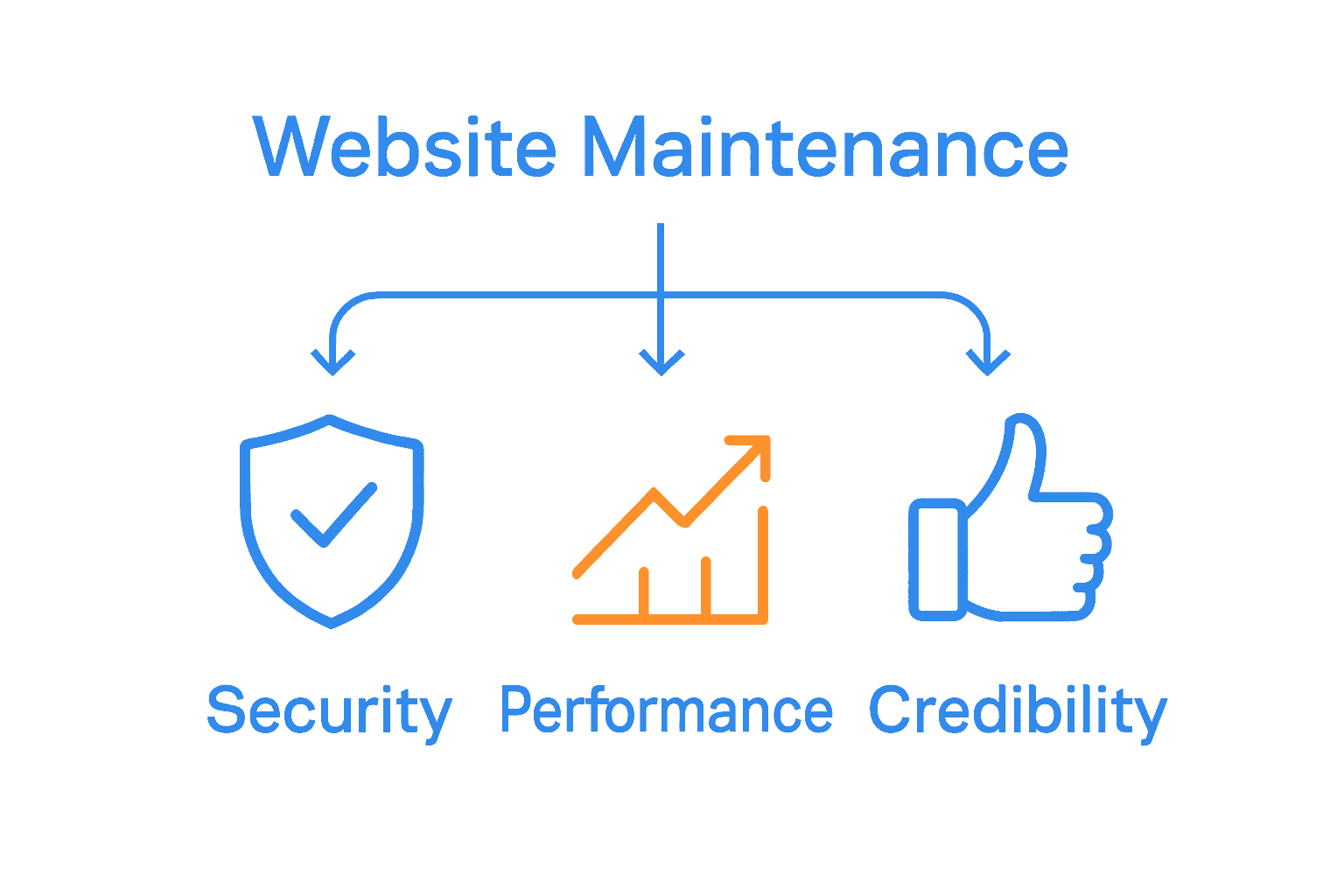A single outdated plugin can put your entire website at risk, with over 30 percent of hacked websites traced back to neglected maintenance. For any business with an online presence, keeping your site secure and performing well is no longer optional. Reliable website maintenance lays the groundwork for strong digital security, smooth user experiences, and higher search rankings. Knowing what goes into proper upkeep can help you avoid costly errors and maximize results from your digital investment.
Table of Contents
- Website Maintenance Defined And Core Principles
- Common Types Of Website Maintenance Tasks
- Key Benefits For Business And Security
- Risks Of Neglecting Website Maintenance
- Costs, Scheduling, And Best Practice Strategies
Key Takeaways
| Point | Details |
|---|---|
| Importance of Maintenance | Regular website maintenance is essential for optimal performance, security, and user experience. It helps prevent issues before they arise, preserving the website’s reputation and functionality. |
| Types of Maintenance | Key activities include technical, content, and security maintenance, focusing on updates, performance optimization, and vulnerability protection. Each category plays a vital role in maintaining a robust online presence. |
| Consequences of Neglect | Failing to maintain a website can lead to security vulnerabilities, decreased search engine rankings, and a poor user experience, ultimately damaging customer trust and business credibility. |
| Investment in Strategy | Effective website maintenance requires strategic planning and budgeting, with regular scheduling to minimize risks and ensure long-term digital success. Investing in this area can yield significant returns for businesses. |
Website Maintenance Defined and Core Principles
Website maintenance is the strategic process of keeping a digital platform healthy, functional, and performing at its best. According to Mailchimp, it involves comprehensive tasks like ensuring all links are operational, updating content regularly, and addressing technical issues proactively.
At its core, website maintenance encompasses a range of critical activities designed to preserve and enhance a website’s effectiveness. As IFTM University explains, this practice involves monitoring overall site health and systematically making updates to maintain long-term value. Key maintenance activities include:
- Updating core website software and plugins
- Testing site functionality and performance
- Implementing regular security patches
- Backing up website data consistently
- Monitoring site speed and user experience
Effective website maintenance isn’t just about fixing problems—it’s about preventing them. By regularly reviewing and updating your digital infrastructure, businesses can avoid potential security vulnerabilities, ensure optimal performance, and provide a seamless experience for visitors. Check out our comprehensive guide on website maintenance best practices to understand how proactive maintenance can transform your online presence.
Common Types of Website Maintenance Tasks
Website maintenance encompasses a variety of strategic tasks designed to keep your digital platform running smoothly and efficiently. These tasks can be categorized into several critical areas that address different aspects of website performance, security, and user experience.
Technical Maintenance involves the behind-the-scenes work that keeps your website functioning optimally. This includes:
- Software and plugin updates
- Security patch implementations
- Server configuration checks
- Performance optimization
- Compatibility testing across different browsers and devices
Content Maintenance is equally crucial for keeping your website relevant and engaging. This area focuses on:
- Updating existing content
- Removing outdated information
- Adding fresh blog posts or articles
- Checking and fixing broken links
- Ensuring content accuracy and relevance
Security Maintenance represents a critical component of website management. Businesses must remain vigilant about potential vulnerabilities, implementing robust security protocols to protect against cyber threats. Our comprehensive website maintenance checklist provides detailed insights into maintaining robust digital security for your online platform.
Performance and visual maintenance also play significant roles, involving regular speed tests, responsive design checks, and ensuring that all visual elements function correctly across different devices and screen sizes. By systematically addressing these maintenance categories, businesses can create a reliable, secure, and high-performing online presence that effectively serves their digital objectives.
Key Benefits for Business and Security
Website maintenance delivers critical strategic advantages that extend far beyond simple technical upkeep. Business performance and digital security are intrinsically linked to how consistently and effectively an organization manages its online presence.
From a business perspective, regular website maintenance provides several transformative benefits:
- Improved search engine rankings
- Enhanced user experience and customer engagement
- Increased website loading speed
- Reduced risk of technical failures
- Higher conversion rates and customer retention
Security represents another paramount consideration for businesses investing in comprehensive website maintenance. Cyber threats continue to evolve rapidly, making proactive maintenance crucial for protecting sensitive digital assets. Explore our guide on essential website security best practices to understand how strategic maintenance can shield your digital infrastructure from potential vulnerabilities.
Moreover, consistent maintenance helps businesses maintain professional credibility. A well-maintained website signals to customers that an organization is reliable, technologically competent, and committed to providing a seamless digital experience. By preventing potential security breaches, minimizing downtime, and ensuring optimal performance, website maintenance becomes a critical investment in a company’s digital reputation and long-term success.

Risks of Neglecting Website Maintenance
Website maintenance neglect can transform your digital presence from a powerful business asset into a significant liability. The consequences of overlooking routine website management extend far beyond mere technical inconveniences, potentially jeopardizing your entire online reputation and business operations.
The most immediate and critical risks include:
- Increased vulnerability to cybersecurity threats
- Dramatic drop in search engine rankings
- Poor user experience leading to customer abandonment
- Potential data breaches and system vulnerabilities
- Reduced website performance and loading speeds
- Loss of customer trust and professional credibility
Identifying potential website mistakes early can help businesses prevent these devastating outcomes. Cybercriminals actively target websites with outdated software, unpatched security vulnerabilities, and inconsistent maintenance protocols. A single overlooked security update can create an entry point for malicious attacks that could compromise sensitive customer data, financial information, and your entire digital infrastructure.
Moreover, search engines like Google continuously update their algorithms to prioritize well-maintained, secure, and fast-loading websites. Neglecting website maintenance means your digital platform becomes increasingly invisible to potential customers, effectively rendering your online presence obsolete. The cumulative impact goes beyond immediate technical issues – it directly affects your brand’s perceived reliability, professionalism, and long-term digital sustainability.
Costs, Scheduling, and Best Practice Strategies
Website maintenance is not a one-size-fits-all approach but a strategic investment that requires careful planning, budgeting, and systematic execution. Understanding the financial implications and developing a comprehensive maintenance strategy can transform what might seem like an expense into a critical business asset.
Cost considerations for website maintenance typically fall into several key categories:
- Routine software updates and security patches
- Performance monitoring and optimization
- Content management and refresh
- Security infrastructure enhancements
- Backup and recovery systems
- Professional technical support
Scheduling maintenance demands a proactive and structured approach. Most businesses benefit from a tiered maintenance strategy that includes:
- Daily quick checks
- Weekly performance reviews
- Monthly comprehensive audits
- Quarterly in-depth system evaluations
- Annual complete website overhaul and strategic review
Understanding website performance monitoring can help businesses develop more precise maintenance schedules tailored to their specific digital infrastructure. Small businesses might allocate between R5,000 to R20,000 annually for comprehensive maintenance, while larger enterprises could invest R50,000 to R250,000 depending on complexity and scale.
The most effective maintenance strategies prioritize prevention over reaction.
 By implementing consistent, scheduled maintenance protocols, businesses can minimize unexpected downtime, reduce long-term repair costs, and ensure their digital platforms remain secure, efficient, and aligned with evolving technological standards.
By implementing consistent, scheduled maintenance protocols, businesses can minimize unexpected downtime, reduce long-term repair costs, and ensure their digital platforms remain secure, efficient, and aligned with evolving technological standards.
Keep Your Website Secure and Performing at Its Best with Expert Support
Neglecting your website maintenance puts your business at risk of downtime, security breaches, and lost customers. You want a flawless, fast, and secure online presence that builds trust, ranks well, and delights your visitors. The article highlights how important regular updates, security patches, and content refreshes are to protect your digital platform from threats and maintain professional credibility. If you are worried about the technical challenges or the time demands of keeping your website in top shape, you do not have to do it alone.
Act now to safeguard your website’s future with tailored solutions from CloudFusion. Our custom web development team can offer a comprehensive web design and development quotation that includes maintenance plans designed to fit your business needs and budget. Protect your digital investment by choosing proactive maintenance that ensures peak performance, strong security, and a seamless user experience. Visit CloudFusion today and start securing your online success.
Discover how our expertise in web design and ongoing support can prevent costly downtime and maintain your digital reputation. Take the first step now by requesting a personalised web design and development quotation tailored specifically for your business goals.
Frequently Asked Questions
What is website maintenance?
Website maintenance is the process of keeping a digital platform healthy, functional, and performing at its best. It involves updating software, monitoring site health, resolving technical issues, and ensuring content relevance.
Why is regular website maintenance important for businesses?
Regular website maintenance is crucial as it improves search engine rankings, enhances user experience, increases loading speeds, and reduces the risk of technical failures and security breaches, ultimately leading to higher conversion rates.
What are common tasks involved in website maintenance?
Common website maintenance tasks include updating software and plugins, testing site performance, implementing security patches, backing up data, and refreshing website content to keep it accurate and engaging.
What are the risks of neglecting website maintenance?
Neglecting website maintenance can lead to increased vulnerability to cyber threats, decreased search engine visibility, poor user experience, potential data breaches, and ultimately loss of customer trust and credibility.
Recommended
- 7 Essential Website Maintenance Best Practices
- Essential Website Maintenance Checklist for All Businesses
- Website Development by Cloudfusion
- Mobile-Friendly Website Importance: Complete Guide
- Preventive Maintenance Checklist for Diesel Injection Pros – My WordPress
- Why Maintain Coffee Machines: Complete Expert Guide - Coffee Sensor








